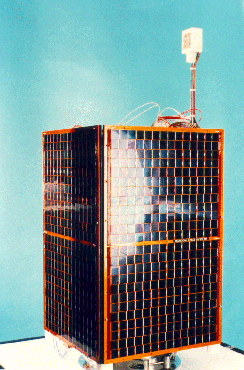 UoSAT-OSCAR 14
UoSAT-OSCAR 14 UoSAT-OSCAR 14
UoSAT-OSCAR 14 Satellite Summary
Satellite SummaryDownlink:
 Description
DescriptionUoSAT-OSCAR14 spent its first 18 months in orbit operating as an amateur store and forward satellite. In early 1992, all amateur operations were moved from AO-14 to UoSAT-OSCAR 22. AO-14 operations were then dedicated for use by VITA (Volunteers In Technical Assistance) who used it for sending and receiving messages in Africa. The computer used for store and forward communications became non-operational. In March 2000 UO-14 was reconfigured as a single channel FM repeater. Since then UO-14 was very popular as an FM repeater in space. Unfortunately, its uplink was only 5 kHz below KO-25's uplink and both satellites are tracking close to one another in their orbits. As a result, KO-25's uplink was often blocked by FM stations accessing UO-14, and several UO-14 users have reported hearing 9600 baud data transmissions destined for KO-25 through UO-14.
In November 2003 UO-14 was been declared officially dead. The Mission Control Centre at the Surrey Satellite Technology Ltd (SSTL) Center for Satellite Engineering Research reported that the venerable and popular bird "has reached the end of its mission after nearly 14 years in orbit. Since launch, UO-14 has completed over 72,000 orbits and as many charge/discharge cycles of its on-board NiCd battery," said AMSAT-UK Chairman Martin Sweeting, G3YJO. "However recently one of the battery cells has become exhausted and can no longer support continuous operation of the repeater." Sweeting said UO-14's transmitter shuts down shortly after it is commanded "on" due to undervoltage, so the microsatellite's mission has been terminated. "Thank you UO-14 for your long service!" Sweeting concluded.
For more information see:
 References
References
Last update November 16, 2003 - N7HPR